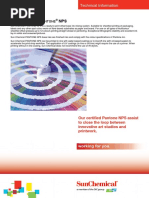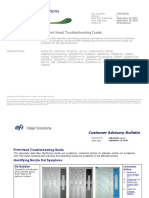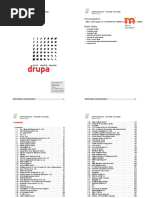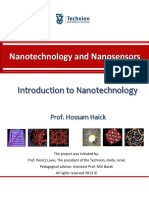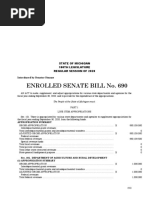Fountain Solution
Fountain Solution
Uploaded by
allUddinCopyright:
Available Formats
Fountain Solution
Fountain Solution
Uploaded by
allUddinOriginal Title
Copyright
Available Formats
Share this document
Did you find this document useful?
Is this content inappropriate?
Copyright:
Available Formats
Fountain Solution
Fountain Solution
Uploaded by
allUddinCopyright:
Available Formats
pH, Conductivity
and
Offset Printing
EuGene Van Roy
1
Pressroom Chemistry 2/26/02
Introduction
! At heart, lithography is a chemical process with
potential for many variables which may affect
production and the quality of offset printing.
! Of the many facets of offset printing perhaps
none is as prone to variation as fountain solution,
but while the cause and nature of these variations
may seem complicated, controlling them is
relatively simple.
2
Pressroom Chemistry 2/26/02
pH, Conductivity and Offset Printing 1
Agenda
! What is the purpose of fountain solution?
! How important is the water source?
! What is pH, and determining pH?
! What is conductivity and how do we
measure conductivity?
! Problems caused by incorrectly mixed
fountain solution?
3
Pressroom Chemistry 2/26/02
Overview
! In 1796, Alois Senefelder applied an oil
type ink on stone, and found that water
adhered to the non-image area only.
With trial and time, more sophisticated
methods were developed. This was done
by using chemicals in the water, in
conjunction with metal plates which have
oleophilic (ink receptive) and hydrophilic
(water receptive) surfaces.
4
Pressroom Chemistry 2/26/02
pH, Conductivity and Offset Printing 2
Overview
! In Senefelder’s day he
went to the well, got a
bucket of water, and
was ready to go. If
things were only that
simple. We will look
at how we can make
the complex variables
of fountain solution
simple.
5
Pressroom Chemistry 2/26/02
What is the purpose of
Fountain Solution?
6
Pressroom Chemistry 2/26/02
pH, Conductivity and Offset Printing 3
Fountain Solution
! The dampening of the offset plate is one
of the most critical factors in quality offset
printing.
! A solution of a fountain concentrate mixed
with water is created that performs several
essential functions on press.
! The most important of these is the wetting
and desensitizing of the non-image area of
the plate.
7
Pressroom Chemistry 2/26/02
Fountain Solution
! Fountain solution lubricates the plate and
blanket, helping to reduce image wear and
prolong plate life.
! Fountain solution cools and helps to
maintain the working properties of ink.
! Fountain solution aids in proper blanket
release, which reduces piling on the
blanket.
8
Pressroom Chemistry 2/26/02
pH, Conductivity and Offset Printing 4
Fountain Solution
! The pH and conductivity of the fountain
solution are of major importance if the
fountain solution is to properly fulfill it’s
function of preventing plate non-image
areas from accepting ink.
! Mixing solution should be done on a daily
basis for small duplicators, and tested daily
on large presses with holding tanks.
! The fresher, the better!
9
Pressroom Chemistry 2/26/02
Fountain Solution Components
! Most fountain solutions are made up of
five basic ingredients and water.
"Acid.
"A wetting agent (surfactants).
"Plate conditioners (chemical salts).
"Gum arabic.
"A buffering agent.
10
Pressroom Chemistry 2/26/02
pH, Conductivity and Offset Printing 5
Fountain Solution Components
! Acid.
"Usually a mild acid, which helps reduce
the pH and keeps the image area
sensitive to ink and the non-image area
more sensitive to water.
11
Pressroom Chemistry 2/26/02
Fountain Solution Components
! A wetting agent.
"Sometimes referred to as surfactants,
these are used to lower the surface
tension of the water allowing it to
maintain the wetting ability of the
fountain solution in the non-image areas,
while allowing you to run less water.
Common agents used are: Isopropyl
Alcohol, Glycerin, and various Glycols.
12
Pressroom Chemistry 2/26/02
pH, Conductivity and Offset Printing 6
Fountain Solution Components
! Plate conditioners (chemical salts).
"These are used to minimize the
corrosive action of the acid on the
surface of an aluminum or metal plate.
This is designed to increase the print
quality and to extend the life of the
plates. Most solutions also contain anti-
foaming and anti-fungus ingredients.
13
Pressroom Chemistry 2/26/02
Fountain Solution Components
! Gum arabic.
"Gum arabic has already been added
to most fountain solution concentrates
made today. It’s function is to adhere to
the plate’s non-image area and protect
it from accepting ink. Gum also serves
to protect the plate from humidity and
chemical attack during press stops.
14
Pressroom Chemistry 2/26/02
pH, Conductivity and Offset Printing 7
Fountain Solution Components
! A buffering agent.
"A substance capable of neutralizing acids and
bases in solutions and thereby maintaining the
acidity or alkalinity level of the solution.
"Keeps the pH constant or within a certain
range regardless of how much acid is added.
"Neutralizes the effects of paper, inks, gases,
and humidity.
15
Pressroom Chemistry 2/26/02
Fountain Solution Components
! Alcohol in dampening solutions.
"Alcohol is added to the fountain solution as
a surfactant. It makes the water wetter. By
reducing the surface tension of the water
the water will spread out to a thinner film.
16
Pressroom Chemistry 2/26/02
pH, Conductivity and Offset Printing 8
Fountain Solution Components
! Alcohol in dampening solutions.
"Isopropyl alcohol is a volatile organic
compound. As a VOC alcohol pollutes our
pressroom and our environment. It is
recommended to use alcohol substitutes.
17
Pressroom Chemistry 2/26/02
How important
is the
Water
source?
pH, Conductivity and Offset Printing 9
Water
! Since approximately 98% of a working
fountain solution is water, being aware of
your water condition is of vital importance.
! Water can be either hard or soft, acid or
alkaline. In fact, water quality can vary
seasonally, monthly, weekly, or even daily.
19
Pressroom Chemistry 2/26/02
Water
! Understand that tap water can be a variable
when used in fountain solution because
some minerals and chemicals in the water
may not be compatible with the chemicals
in the fountain solution concentrate.
20
Pressroom Chemistry 2/26/02
pH, Conductivity and Offset Printing 10
Water
! There are three stable substitutes for tap
water: De-ionized, Distilled, and Reverse
Osmosis water.
21
Pressroom Chemistry 2/26/02
Water
! De-ionization, or the demineralization
process.
"A complex chemical process that uses two
ion exchange resins to remove minerals
from water. The cost of this method is
considerably less than the cost of producing
distilled water.
22
Pressroom Chemistry 2/26/02
pH, Conductivity and Offset Printing 11
Water
De-ionization, or
Demineralization
unit
Water
! Distilled water.
"Produced in a laboratory by boiling ordinary
tap water in a water still. The steam that rises
from the boiling water is almost free of the
mineral matter present in the tap water. The
steam is fed through condenser coils where
it is converted into liquid, distilled water.
Some fountain solutions do not work well
with distilled water.
24
Pressroom Chemistry 2/26/02
pH, Conductivity and Offset Printing 12
Water
Distilled
Water
Unit
Water
! Reverse Osmosis water.
"The best method of water purification. In
this process the water is filtered through a
membrane to remove most of the positive
and negative ions, un-ionized dissolved solids
(sugars), suspended matter, and bacteria
leaving only pure water.
"Sometimes referred to as “RO water”.
26
Pressroom Chemistry 2/26/02
pH, Conductivity and Offset Printing 13
Water
Reverse
Osmosis
Unit.
Water
! What is Hard Water?
28
Pressroom Chemistry 2/26/02
pH, Conductivity and Offset Printing 14
Hard Water Is:
"Tap water is rarely pure.
"Ions associated with minerals and inorganic
compounds in water make it “hard”.
"Through formation of oleaginous (oily) soaps,
hard water can play havoc with press
operations (roller stripping, halftone fill-in).
"Water hardness is rated in terms of total
concentration of calcium carbonate ions.
29
Pressroom Chemistry 2/26/02
Water
! How do we evaluate water hardness?
30
Pressroom Chemistry 2/26/02
pH, Conductivity and Offset Printing 15
We evaluate water hardness by:
"Water hardness usually is indicated in parts
per million (PPM) (or milligrams pre liter
(mg/l) or grains/gallon) of calcium carbonate.
"Water hardness varies from locality to
locality.
"The best source for determining water
hardness is the local water company.
"Water hardness can be estimated by using a
conductivity meter.
31
Pressroom Chemistry 2/26/02
We evaluate water hardness by:
32
Pressroom Chemistry 2/26/02
pH, Conductivity and Offset Printing 16
Water
Softener.
Water
! What is water alkalinity?
34
Pressroom Chemistry 2/26/02
pH, Conductivity and Offset Printing 17
Water alkalinity is:
"Alkalinity neutralizes acids.
"Tap water with high levels of alkalinity are
most common in areas with limestone deposits.
"Alkalinity is measured and expressed in PPM,
mg/l or grains/gallon.
"In areas with alkaline water, alkalinity is more
important than water hardness because
excessive levels shift pH towards neutral.
35
Pressroom Chemistry 2/26/02
What is pH?
36
Pressroom Chemistry 2/26/02
pH, Conductivity and Offset Printing 18
What is pH? (History)
! For those who wonder how the term pH
came by its odd spelling, the Romans
knew pH as “potentia hydrogenii,”
or “potential for Hydrogen,” and thus
the small “p” and capital “H”.
! All the press operator really needs to
know about pH is that it is a measure of
the degree of acidity or alkalinity of
fountain solution.
37
Pressroom Chemistry 2/26/02
What is the pH Scale?
" The pH scale runs from 0 to 14.0.
" 7.0, the mid-point on the pH scale, is neutral.
" A solution with a pH of less than 7.0 is acid. A
solution with a pH of more than 7.0 is alkaline
(base).
" A whole-number change on the pH scale
represents a tenfold change in pH. Small
differences on the scale, in practical terms,
may be quite large.
38
Pressroom Chemistry 2/26/02
pH, Conductivity and Offset Printing 19
What is the pH Scale?
What is the pH Scale?
" Each whole number on the pH scale represents
a tenfold change in acidity or alkalinity.
" A solution at (pH 5.0 is 10 times more acidic
than a pH 6.0) and a solution at (pH 4.0 is 100
times more acidic than a pH 6.0).
" A solution at (pH 9.0 is 10 times more alkaline
than a pH 8.0) and a solution at (pH 10.0 is 100
times more alkaline than a pH 8.0).
40
Pressroom Chemistry 2/26/02
pH, Conductivity and Offset Printing 20
Determining pH.
41
Pressroom Chemistry 2/26/02
Determining pH.
" There are two basic methods for checking
pH in the industry: with chemically-coated
indicator papers (strips), and with
electronic pH meters.
" Indicator papers and strips tend to be
inaccurate.
" Battery-operated, portable pH meters are
reliable and easy to use.
42
Pressroom Chemistry 2/26/02
pH, Conductivity and Offset Printing 21
Determining pH.
" Ink-makers recommend a fountain pH
of 4.5 – 5.0 for optimal performance.
" Certain duplicators, using paper plates,
may require a slightly lower pH.
" Higher pH readings may cause scumming
and toning, whereas pH readings of less
than 4.0 may retard or inactivate ink
drying by locking up the catalytic dryers
in the ink.
43
Pressroom Chemistry 2/26/02
Determining pH. (Buffering)
" Without getting over-technical, buffers
are chemicals that are used in fountain
concentrates to help stabilize the pH
level of the mixed solution.
" Buffers reduce the tendency of pH to
drift (becoming more acidic or alkaline)
due to the introduction of contaminants
such as paper coatings, inks, wash-up
solutions, and any other contaminant
you can think of.
44
Pressroom Chemistry 2/26/02
pH, Conductivity and Offset Printing 22
Determining pH.
! When purchasing fountain solution:
"Is it a buffered or non-buffered solution?
"Is it compatible with your water source?
"Does the fountain solution provide the correct
pH level and compatibility specified by the
ink and plate manufacturers?
"Do Not use a variety of different solutions!
Find one that works for your type of printing.
45
Pressroom Chemistry 2/26/02
What is conductivity?
46
Pressroom Chemistry 2/26/02
pH, Conductivity and Offset Printing 23
What is conductivity?
! Conductivity is the ability to transmit or
conduct an electrical charge.
! The degree of conductivity is determined
by the number of ions present as a result of
minerals or other compounds in the water.
! The higher the concentration of ions, the
higher the degree of conductivity (and
usually the harder the water).
47
Pressroom Chemistry 2/26/02
What is conductivity?
! Water normally has a very low ion level
and registers very low in conductivity.
! Alcohol does not conduct an electric
charge and has a conductivity reading of 0,
as does glycerin.
! Therefore alcohol and glycerin act to dilute,
reducing the solution’s conductivity
reading.
48
Pressroom Chemistry 2/26/02
pH, Conductivity and Offset Printing 24
Why the need for conductivity?
! With the new technology that has evolved
in the printing industry, including buffered
and neutral fountain solutions, pH is not
enough in determining the best level of
performance of a fountain solution.
! Conductivity gives a more accurate way
to monitor the conductivity level
throughout a press run.
49
Pressroom Chemistry 2/26/02
Why the need for conductivity?
! Whether the press operator adds 3 or 8
ounces of solution to a gallon of water,
the pH will remain the same, but the
over-all chemistry is not correct for the
type of press that you are trying to run!
50
Pressroom Chemistry 2/26/02
pH, Conductivity and Offset Printing 25
Why the need for conductivity?
! Conductivity readings let us know where
our starting solution should be, and if it
becomes contaminated and problems arise
we have a base number to refer back to
regardless of the pH level.
51
Pressroom Chemistry 2/26/02
Why the
need for
conductivity?
This chart shows a
Fountain Solution
buffered at a pH of
4.5
pH, Conductivity and Offset Printing 26
How do we measure
conductivity?
How do we measure
conductivity?
! The unit of measure for expressing
electrical resistance is the “ohm”,
and the unit of measure for expressing
conductivity, the opposite of resistance,
is the”mho”.
54
Pressroom Chemistry 2/26/02
pH, Conductivity and Offset Printing 27
How do we measure
conductivity?
! Because of the difficulty of measuring
conductivity in terms of “mho” units,
a fraction of a mho or a “micromho”
is normally used.
!A micromho is equal to one millionth
of a mho.
55
Pressroom Chemistry 2/26/02
How do we measure
conductivity?
! Conductivity meters are accurate, easy
to calibrate, and simple to use.
! To take a reading just place the electrode
in the solution and stir a few seconds.
! Most conductivity meters are digital and
a reading will appear in the viewer.
56
Pressroom Chemistry 2/26/02
pH, Conductivity and Offset Printing 28
How do we measure
conductivity?
! The level of a solution is measured with a
conductivity meter, which gives readings
in micromhos per centimeter.
! Conductivity should be checked before and
after adding alcohol due to the fact that
alcohol dilutes the solution and will render
a false reading.
57
Pressroom Chemistry 2/26/02
How do we measure
conductivity?
! The rule of thumb for good
conductivity readings is about 900
to 1000 mmhos over the conductivity
of the water.
! The conductivity range encountered
by most printers will be under 3000
micromhos (mmhos).
58
Pressroom Chemistry 2/26/02
pH, Conductivity and Offset Printing 29
How do we measure
conductivity?
! The important fact to remember is
that there is no conductivity standard.
You must determine the individual
standard for your press by conducting
tests.
59
Pressroom Chemistry 2/26/02
Fountain solution problems.
What happens
when too much
concentrate is used
in the fountain
solution?
pH, Conductivity and Offset Printing 30
Too Much Concentrate
! If the recommended dilution ratio of the
fountain concentrate is 2 ounces per gallon,
this does not mean that 4 ounces per gallon
is twice as good.
! Excessive use of fountain concentrate will
cause problems and increase chemistry,
material, and labor costs.
61
Pressroom Chemistry 2/26/02
Too Much Concentrate
! When an overdose of a buffered fountain
concentrate occurs, the pH reading will not
indicate this excess because the buffering
salts limit the pH reading of the solution.
! A conductivity reading, on the other hand,
will prove useful in determining excess
concentrate.
62
Pressroom Chemistry 2/26/02
pH, Conductivity and Offset Printing 31
Too Much Concentrate
! Possible problems from too much concentrate.
"Ink emulsification (especially reds and blues).
"Background tinting.
"Poor ink-acceptance in image area, resulting in
mottling or blinding of the plate.
"Premature plate wear from lack of ink lubrication.
"Slow drying of inks and possibly, of chalking.
"Stripping of the ink rollers.
63
Pressroom Chemistry 2/26/02
Fountain solution problems.
What happens
when too little
concentrate is
used in the
fountain
solution?
pH, Conductivity and Offset Printing 32
Too little Concentrate
! Too little concentrate will cause many of
the active ingredients found in the fountain
solution to be inadequate in strength to do
the job they are designed to do.
! Lack of adequate concentrate can be
determined by both pH and conductivity.
! For best results, stay with a range of pH
and conductivity that is most successful
under your printing conditions.
65
Pressroom Chemistry 2/26/02
Too little Concentrate
! Possible problems from too little
concentrate.
"Filling in of reverses and halftone screens.
"Scumming.
"Tinting.
"Inadequate gum will leave plate non-image
areas unprotected.
"Lack of anti-corrosive ingredients will lead
to premature plate wear.
66
Pressroom Chemistry 2/26/02
pH, Conductivity and Offset Printing 33
Safety First
Safety First
! Use care while mixing to avoid dangerous
splashes.
! Measure out the required amount of water
first.
! Add concentrate to the water.
! If other components are required, add them
to the water/concentrate mixture.
! Stir or mix all components to achieve a
uniform blend.
68
Pressroom Chemistry 2/26/02
pH, Conductivity and Offset Printing 34
Safety First
! Check pH and conductivity to be sure
they meet the manufacturer’s
recommendation (or the pre-established
standards for your press).
! If alcohol is required, add it after the
solution has been mixed to the desired
conductivity range.
69
Pressroom Chemistry 2/26/02
Summary
! pH and Conductivity determinations are
the first logical troubleshooting steps
when press related problems arise.
! Most problems attributed to fountain
solution are due to too much or too little
fountain concentrate and the source water.
! Maintenance and cleaning of dampening
systems will also eliminate a lot of
dampening system problems.
70
Pressroom Chemistry 2/26/02
pH, Conductivity and Offset Printing 35
Where to Get More Information
! The following companies have provided
the information used in this presentation:
" Varn Product Company (201) 337-3600
" Kohl Madden (800) 367-4657
" Kodak Polychrome Corp. (414) 784-3720
" Van Son Ink (800) 645-4182
" GATF http://www.gatf.org
71
Pressroom Chemistry 2/26/02
Thank You
! If you ever need Help!
EuGene L. Van Roy
Western Wisconsin
Technical College
304 N. 6th St.
LaCrosse, WI 54602
(608) 789-6260 or (608)
526-6600
E-mail:
vanroy3@juno.com
72
Pressroom Chemistry 2/26/02
pH, Conductivity and Offset Printing 36
You might also like
- Exam: SC-900 Title: Microsoft Security, Compliance, and Identity Fundamentals Vendor: Microsoft Questions: 238Document52 pagesExam: SC-900 Title: Microsoft Security, Compliance, and Identity Fundamentals Vendor: Microsoft Questions: 238zawzaw htet100% (2)
- User Manual Flenex FW 1.3.Document64 pagesUser Manual Flenex FW 1.3.ClaudiNo ratings yet
- FIRST 6.0: Flexographic Image Reproduction Specifications and TolerancesFrom EverandFIRST 6.0: Flexographic Image Reproduction Specifications and TolerancesNo ratings yet
- Relationships Between The Surface Texture of Flexographic Printing Plates and The Printability of Kraft PaperDocument11 pagesRelationships Between The Surface Texture of Flexographic Printing Plates and The Printability of Kraft PaperQuý Đình Mai MaiNo ratings yet
- Howard Staunton - The Chess Tournament of 1851 (1851)Document502 pagesHoward Staunton - The Chess Tournament of 1851 (1851)WolfgangvonNachtundLebenNo ratings yet
- Fountain Solution ChemistryDocument3 pagesFountain Solution ChemistryforeverhaleemNo ratings yet
- Fountain Solution BrochureDocument14 pagesFountain Solution BrochurecarloadugNo ratings yet
- KBA-Rapida 75 I Part EnglDocument8 pagesKBA-Rapida 75 I Part EnglKBR Graphics CanadaNo ratings yet
- Narrow-Web-Brochure Flexo WashDocument20 pagesNarrow-Web-Brochure Flexo WashQuý Đình Mai MaiNo ratings yet
- Navigator 9 User Manual PDFDocument444 pagesNavigator 9 User Manual PDFLalo GutierrezNo ratings yet
- Press: Flexible. Easy. Intelligent. Accurate Color On All Printing DevicesDocument4 pagesPress: Flexible. Easy. Intelligent. Accurate Color On All Printing DevicesmigueldemacrolabNo ratings yet
- Fountain Solution in OffsetDocument22 pagesFountain Solution in OffsetTomColl66No ratings yet
- 1309 FlexoTech Colour Management For Flexo Part IIDocument3 pages1309 FlexoTech Colour Management For Flexo Part IITomColl66No ratings yet
- 2 - Phu Luc 2 - Print - Control - SystemDocument1 page2 - Phu Luc 2 - Print - Control - SystemLý Phương NamNo ratings yet
- UV Curable Inks: Will They Work For Everyone?: by Mike UkenaDocument4 pagesUV Curable Inks: Will They Work For Everyone?: by Mike UkenaMark LesterNo ratings yet
- Raster Image Processor: Built-In Dot ViewerDocument2 pagesRaster Image Processor: Built-In Dot ViewerLý Phương Nam100% (1)
- Profi Tip Dampening Solutions in Offset Printing: Print Media AcademyDocument20 pagesProfi Tip Dampening Solutions in Offset Printing: Print Media AcademyamineNo ratings yet
- Thuvienmayin PDFDocument51 pagesThuvienmayin PDFNgoc TanNo ratings yet
- Grafikontrol WebOffset EN PDFDocument20 pagesGrafikontrol WebOffset EN PDFaiureala2No ratings yet
- Rapida 105 PRO - Best in ClassDocument34 pagesRapida 105 PRO - Best in ClassHamed OnsoriNo ratings yet
- 3 Profi Tipp Rollers in InkingDocument15 pages3 Profi Tipp Rollers in InkingSadif MahmutovicNo ratings yet
- S C P NPS: UN Hemical AntoneDocument4 pagesS C P NPS: UN Hemical AntoneTanjaNo ratings yet
- Inkformation 4 en 02Document28 pagesInkformation 4 en 02MohammadAlAmeenNo ratings yet
- Tension Controller Electromagnetic Clutch/Brake General Catalog 2018Document162 pagesTension Controller Electromagnetic Clutch/Brake General Catalog 2018Sajjad HussainNo ratings yet
- Flexo Uv Ink TroubleshootingDocument22 pagesFlexo Uv Ink TroubleshootingHiba Naser100% (1)
- Waste Analysis and Scope of Wastage Reduction in Sheetfed Offset PrintingDocument26 pagesWaste Analysis and Scope of Wastage Reduction in Sheetfed Offset PrintingDivakar ShenoyNo ratings yet
- Difference Between Impact Printers and Nonimpact PrintersDocument3 pagesDifference Between Impact Printers and Nonimpact PrintersMohammad Imranul HoqueNo ratings yet
- Steinemann Flyer A4 Colibri76 108 en 2016 WebDocument4 pagesSteinemann Flyer A4 Colibri76 108 en 2016 WebAnderson AntunesNo ratings yet
- Jetrion 4900M & Jetrion 4900M-330: Flexible and Profi Table Label Printing SolutionsDocument4 pagesJetrion 4900M & Jetrion 4900M-330: Flexible and Profi Table Label Printing SolutionsWillian BrandãoNo ratings yet
- CAB-00426 Print Head Troubleshooting Guide LDocument4 pagesCAB-00426 Print Head Troubleshooting Guide LBruce CampanelliNo ratings yet
- Understanding Working Principles Laser Printer: Click To Edit Master Subtitle StyleDocument13 pagesUnderstanding Working Principles Laser Printer: Click To Edit Master Subtitle StyleJucia ChawNo ratings yet
- KBA PresentationDocument48 pagesKBA PresentationMega Tunisia TNo ratings yet
- Mycatalog Drupa08 Prod 01 e PDFDocument660 pagesMycatalog Drupa08 Prod 01 e PDFMULYADINo ratings yet
- Options MAY14Document20 pagesOptions MAY14Enrique VasquezNo ratings yet
- Harper Anilox RollDocument88 pagesHarper Anilox Rollsuracheted0% (1)
- Out of PrintDocument256 pagesOut of PrintjliviuNo ratings yet
- Offset TrialDocument64 pagesOffset TrialOgi Permana PutraNo ratings yet
- MDPI Introduction About Inkjet Printing Technology and Inkjet InksDocument26 pagesMDPI Introduction About Inkjet Printing Technology and Inkjet Inkslydiem09100% (1)
- Color EditorDocument70 pagesColor EditorP LNo ratings yet
- JetXpert - Why You Should Pursue Grayscale PrintingDocument6 pagesJetXpert - Why You Should Pursue Grayscale Printingindika lakmalNo ratings yet
- Specification of The CIP3 Print Production FormatDocument62 pagesSpecification of The CIP3 Print Production FormatBoban TrajcevskiNo ratings yet
- MSDS Uv 2Document14 pagesMSDS Uv 2DewiNo ratings yet
- Device Link ProfileDocument28 pagesDevice Link ProfileMarcos Flint0% (1)
- Heidelberg PR HEI PRODUCTIVTY Coimbatore Open HouseDocument3 pagesHeidelberg PR HEI PRODUCTIVTY Coimbatore Open HouseHeidelberg IndiaNo ratings yet
- BB Pressroom Supplie N Parts Lr2Document84 pagesBB Pressroom Supplie N Parts Lr2Chloe JohnsonNo ratings yet
- Heidelberg Sign A Setter ProDocument10 pagesHeidelberg Sign A Setter ProAlexander MooneyNo ratings yet
- 213 Manual SpectroPlateDocument44 pages213 Manual SpectroPlateKarlis Silva CárdenasNo ratings yet
- Basics of Printing ProcessessDocument4 pagesBasics of Printing ProcessessSarath Sachu100% (1)
- Workflow Solutions IndigoDocument8 pagesWorkflow Solutions IndigoByaruhanga EmmanuelNo ratings yet
- Problem Cases in The PressroomDocument45 pagesProblem Cases in The PressroomHeidelberg IndiaNo ratings yet
- Get Production Rolling With Rotary Screen PrintingDocument8 pagesGet Production Rolling With Rotary Screen PrintingK.SaravananNo ratings yet
- Ugra Offsettestkeil 1982 Manual enDocument16 pagesUgra Offsettestkeil 1982 Manual enecdtcenterNo ratings yet
- Flexo: Combination Printing: Arwan SiregarDocument5 pagesFlexo: Combination Printing: Arwan Siregararwan75No ratings yet
- Unwinding StationDocument34 pagesUnwinding StationDeniMestiWidiantoNo ratings yet
- Fogra Softproof Handbook PDFDocument43 pagesFogra Softproof Handbook PDFLalo GutierrezNo ratings yet
- Speedmaster SX 74 Product InformationDocument20 pagesSpeedmaster SX 74 Product Informationhoussemdellal4No ratings yet
- Ltromat: Operation Manual For The DRC 200 - SystemDocument74 pagesLtromat: Operation Manual For The DRC 200 - Systemsergiyt2100% (1)
- GLX-40/40P en JPN 20P N01 1 Mar.2020 03K TPDocument10 pagesGLX-40/40P en JPN 20P N01 1 Mar.2020 03K TPTrần NamNo ratings yet
- Print Technologies and Design Concepts For Hybrid Printing SystemsDocument6 pagesPrint Technologies and Design Concepts For Hybrid Printing SystemsHữu QuangNo ratings yet
- CTP HistoryDocument125 pagesCTP HistoryPavan SamudralaNo ratings yet
- Delamination in Sheetfed Offset PrintingDocument12 pagesDelamination in Sheetfed Offset PrintingHeidelberg IndiaNo ratings yet
- ICJ 04 18 Jasurek Valis Syrovy JablonovskyDocument3 pagesICJ 04 18 Jasurek Valis Syrovy JablonovskyallUddinNo ratings yet
- Rheology - An Important Tool in Ink DevelopmentDocument3 pagesRheology - An Important Tool in Ink DevelopmentallUddinNo ratings yet
- Nanotechnology and Nanosensors. Introduction To Nanotechnology (PDFDrive) (1) - Split2Document58 pagesNanotechnology and Nanosensors. Introduction To Nanotechnology (PDFDrive) (1) - Split2allUddinNo ratings yet
- Nanotechnology and Nanosensors. Introduction To Nanotechnology (PDFDrive) (1) - Split1Document70 pagesNanotechnology and Nanosensors. Introduction To Nanotechnology (PDFDrive) (1) - Split1allUddinNo ratings yet
- Banknotes and Anti CounterfeiDocument8 pagesBanknotes and Anti CounterfeiallUddinNo ratings yet
- Manual PH Meter PceDocument17 pagesManual PH Meter PceallUddinNo ratings yet
- Vamsa Vriksham-Sriramana-Venditera NavalaDocument108 pagesVamsa Vriksham-Sriramana-Venditera NavalaallUddinNo ratings yet
- 2022 Oct Maths G10 P1Document14 pages2022 Oct Maths G10 P1bbeuii12lenaNo ratings yet
- Analysis of Systems With Complex GearsDocument10 pagesAnalysis of Systems With Complex Gearslk700615No ratings yet
- EnG8 - Q1 - LAS - 5 - RTPDocument5 pagesEnG8 - Q1 - LAS - 5 - RTPAlan OringoNo ratings yet
- Chemistry SCIENCE Paper - 2: (Two Hours)Document9 pagesChemistry SCIENCE Paper - 2: (Two Hours)Puja AgarwalNo ratings yet
- The Mark: Viernes, 31 de Enero de 2020Document3 pagesThe Mark: Viernes, 31 de Enero de 2020kileab5No ratings yet
- Chapter 6 - Action Research Final - EditedDocument8 pagesChapter 6 - Action Research Final - EditedZul4No ratings yet
- LITERATURE MCQ (2)Document4 pagesLITERATURE MCQ (2)nikileshpidipathriNo ratings yet
- Materials System SpecificationDocument5 pagesMaterials System SpecificationFlorante NoblezaNo ratings yet
- Brief History of Fiancial SystemDocument5 pagesBrief History of Fiancial Systempranay chaudharyNo ratings yet
- Assessment 2 Strategic Leadership and Practice PDFDocument14 pagesAssessment 2 Strategic Leadership and Practice PDFBrett Vice100% (1)
- Trusts OutlineDocument20 pagesTrusts OutlineDavid YergeeNo ratings yet
- Application of Derivative Assignement-1Document6 pagesApplication of Derivative Assignement-1Sanjay GuptaNo ratings yet
- Standards Based Lesson Plan - Individual Lesson: Intern: Alyssa Ginzburg Grade Level: 6thDocument3 pagesStandards Based Lesson Plan - Individual Lesson: Intern: Alyssa Ginzburg Grade Level: 6thapi-498343131No ratings yet
- Research SeminarDocument2 pagesResearch Seminardaniefjrd04No ratings yet
- Hydroxy and Keto AcidsDocument14 pagesHydroxy and Keto AcidsSarah FathimaNo ratings yet
- National Climate Assessment - Forest Sector Technical ReportDocument623 pagesNational Climate Assessment - Forest Sector Technical ReportmizzakeeNo ratings yet
- Enrolled Senate Bill No. 690: State of Michigan 100Th Legislature Regular Session of 2020Document14 pagesEnrolled Senate Bill No. 690: State of Michigan 100Th Legislature Regular Session of 2020Caleb HollowayNo ratings yet
- 143_RRB_JE_MCQ_Industrial_MCQ_RRB_INDUSTRIAL_MANAGEMENT_FOR_ - CopyDocument72 pages143_RRB_JE_MCQ_Industrial_MCQ_RRB_INDUSTRIAL_MANAGEMENT_FOR_ - CopybcggNo ratings yet
- ELEGOO MARS 4 MAX Photocuring 3D Printer User ManualDocument20 pagesELEGOO MARS 4 MAX Photocuring 3D Printer User ManualHiroNo ratings yet
- Beamcolumn Capacity CheckDocument14 pagesBeamcolumn Capacity CheckshaimenneNo ratings yet
- SDMP Implementation Accomplishments and UpdatesDocument20 pagesSDMP Implementation Accomplishments and UpdatesJELLY LULABNo ratings yet
- Handbook On Pressurized Irrigation Techniques: ISBN 978-92-5-105817-6Document282 pagesHandbook On Pressurized Irrigation Techniques: ISBN 978-92-5-105817-6lsaishankarNo ratings yet
- Washing Machine Owner's InstructionsDocument24 pagesWashing Machine Owner's InstructionspocepokeNo ratings yet
- Soft Power With Chinese Characteristics: The Ongoing DebateDocument17 pagesSoft Power With Chinese Characteristics: The Ongoing DebateKanka kNo ratings yet
- SOEE3260_Lecture_notes_11_SurfaceWavesDocument13 pagesSOEE3260_Lecture_notes_11_SurfaceWavesShahad AlwahaibNo ratings yet
- 6 SQLDocument110 pages6 SQLKHOA NGUYỄN ĐẶNG ANHNo ratings yet
- Basic Concept of NursingDocument58 pagesBasic Concept of NursingRajesh SharmaNo ratings yet
- The Relationship Between Sleep Quality and Academic Performance Among College StudentsDocument3 pagesThe Relationship Between Sleep Quality and Academic Performance Among College StudentsjoengugiNo ratings yet





















